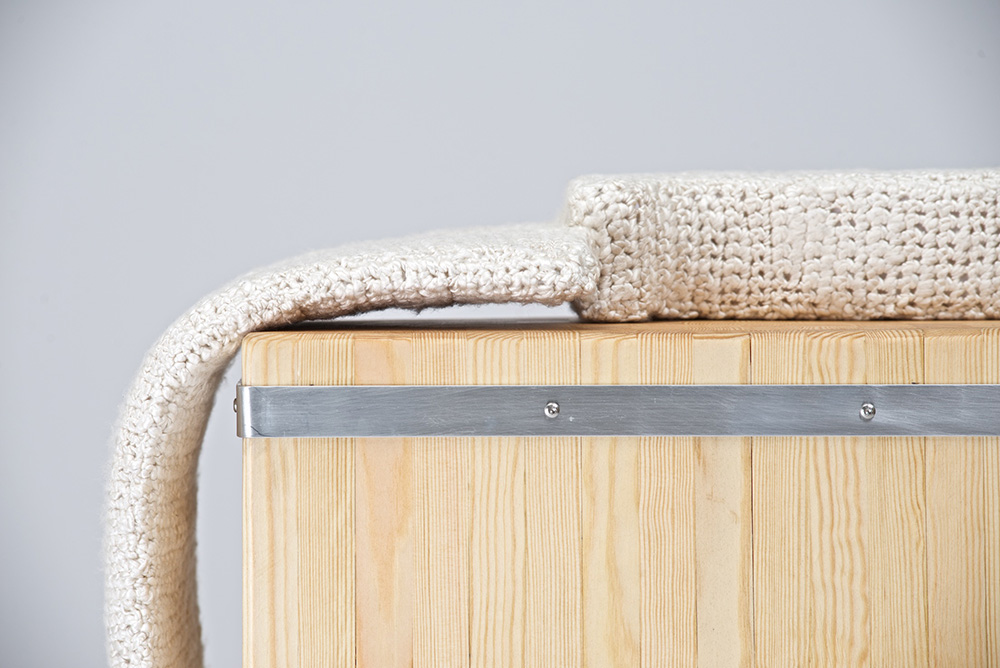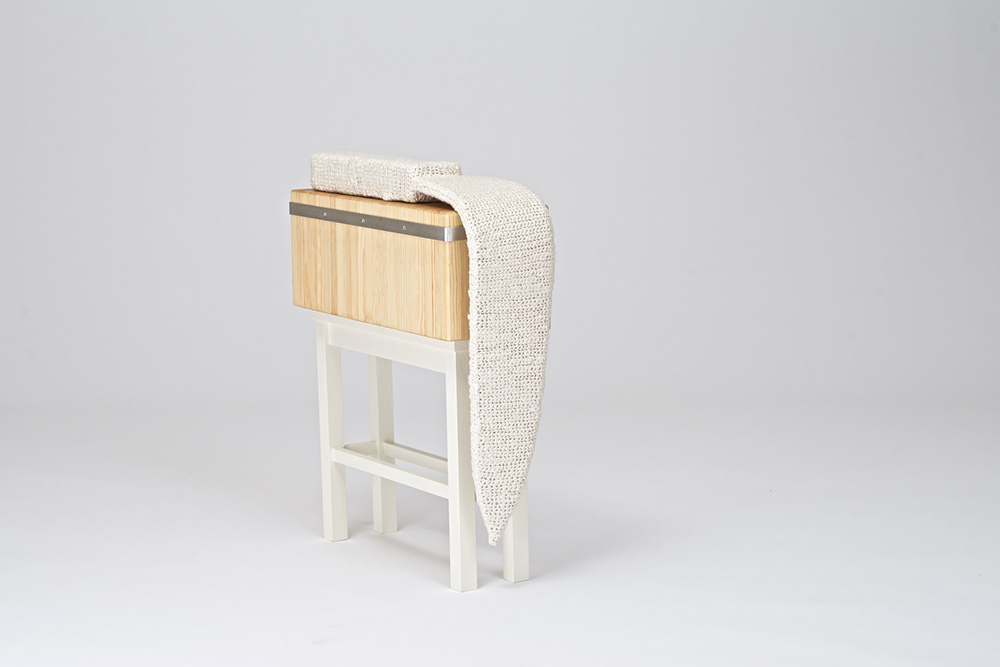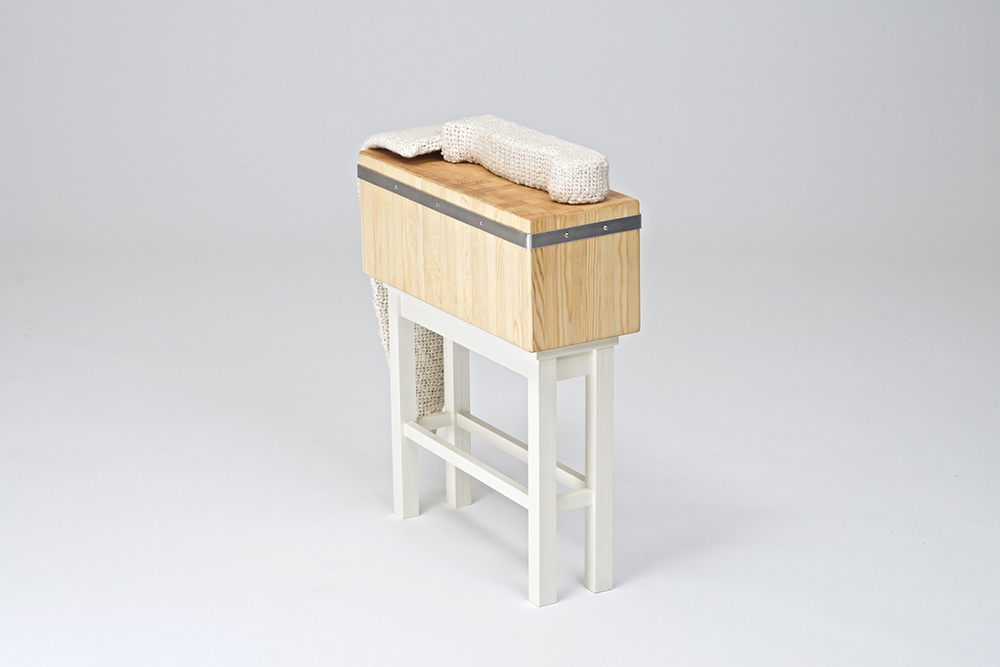CROPPED
2016
Objekt
object
CROPPED
In cropped kulminiert ein Strang meiner künstlerischen Auseinandersetzung, der sich von formaler Materialerkundung (4_squares, 400_squares) über Fragen innerer Zustände (weißes Sofa auf Parkett, Geborgenheit) bis hin zur Dekonstruktion symbolischer Machtobjekte entwickelt hat. Die Arbeit setzt sich auf direktem, fast körperlichem Weg mit Geschlechterbildern und deren kulturellen Codierungen auseinander.
Im Zentrum steht ein Messer – jedoch nicht aus Stahl, sondern aus textilem Material. Das, was gemeinhin als weich, formbar, sinnlich und traditionell weiblich besetzt gilt, nimmt hier die Form eines klassisch männlich konnotierten Macht- und Bedrohungssymbols an. Doch das textile Messer verliert seine Härte. Es liegt schlaff über einem zu kleinen Hackstock, erinnert in seiner Verformung an Dalís fließende Uhr – ein Symbol für das Auflösen fester Zeit, hier übertragbar auf das Auflösen fester Rollen.
Die vermeintliche Bedrohlichkeit des Objekts wird nicht nur infrage gestellt, sondern bewusst unterwandert. Das Messer ist entmachtet, entkernt, „beschnitten“ – und damit auch die patriarchale Symbolik, die ihm traditionell eingeschrieben ist. Durch die textile Transformation wird das dominante Zeichen männlicher Gewalt dekontextualisiert, ironisiert und damit seines Anspruchs auf Unantastbarkeit beraubt.
Wie auch in Geborgenheit steht cropped im Spannungsfeld zwischen Schutz und Bedrohung, zwischen Innerlichkeit und äußerer Form. Doch während Geborgenheit das Zuviel an Nähe und Vertrautheit als erdrückende Gefahr offenlegt, wendet sich cropped der Form gewordenen Aggression zu – und zeigt, wie sich Macht durch Material in Bedeutung verwandelt.
Die Geschlechterrollen treten hier in einen Dialog, der deren Künstlichkeit offenlegt. Was als unerschütterlich männlich galt, verliert durch textile Weichheit seine Bedrohlichkeit. Das traditionell Weibliche übernimmt eine aktive, subversive Rolle – nicht durch Konfrontation, sondern durch Umcodierung.
cropped ist damit nicht nur ein ironisches Spiel mit Form und Erwartung, sondern eine präzise künstlerische Geste: Sie entlarvt das kulturell Konstruierte, löst die Starrheit binärer Zuschreibungen auf und schafft einen Raum für Ambivalenz, Zwischenzustände und das, was jenseits der Grenze liegt.
CROPPED
cropped marks a culmination of an artistic trajectory that began with formal material studies (4_squares, 400_squares), moved through reflections on interior states (White Sofa on Parquet, Geborgenheit), and arrives here at a direct, almost physical interrogation of gendered symbols and cultural codes.
At the center of the work is a knife—not made of steel, but of textile. What is typically considered soft, malleable, sensual, and traditionally coded as feminine takes the shape of a classic symbol of masculine power and threat. But this knife has lost its sharpness. It lies limp over an undersized chopping block, recalling Dalí’s melting clock—here not dissolving time, but dissolving fixed roles.
The supposed threat of the object is not only questioned but deliberately undermined. The knife is disempowered, defused, “cropped”—and so too is the patriarchal symbolism it traditionally embodies. Through its material transformation, this dominant emblem of violence is decontextualized, softened, and stripped of its untouchable status.
As in Geborgenheit, cropped navigates the tension between protection and threat, between interiority and outward form. While Geborgenheit explores the suffocating potential of too much closeness or familiarity, cropped addresses the materialized form of aggression—revealing how power is shaped, and reshaped, by matter.
Masculinity and femininity enter into a dialogue that exposes the constructed nature of their boundaries. What once appeared unquestionably “male” loses its menace through softness. The traditionally “feminine” assumes an active, subversive role—not by confrontation, but through quiet recoding.
cropped is not just an ironic play on form and expectation—it is a precise artistic gesture. It exposes the cultural mechanics of dominance, dissolves the rigidity of binary roles, and opens space for ambiguity, in-betweenness, and what lies beyond fixed categories.





pictures: © Paris Tsitsos


pictures: © flat1 | Ausstellungsansicht – exhibition view: Powerfool, flat1, Vienna, 2016

picture: © eSeL.at – Joanna Pianka | Ausstellungsansicht – exhibition view: The Groupshow, Lothirngerstraße Haus der Kaufmannschaft, Vienna, 2022